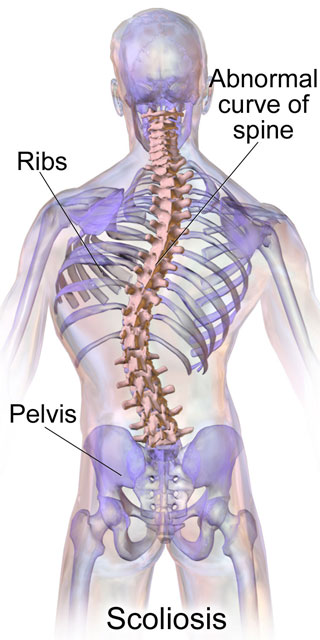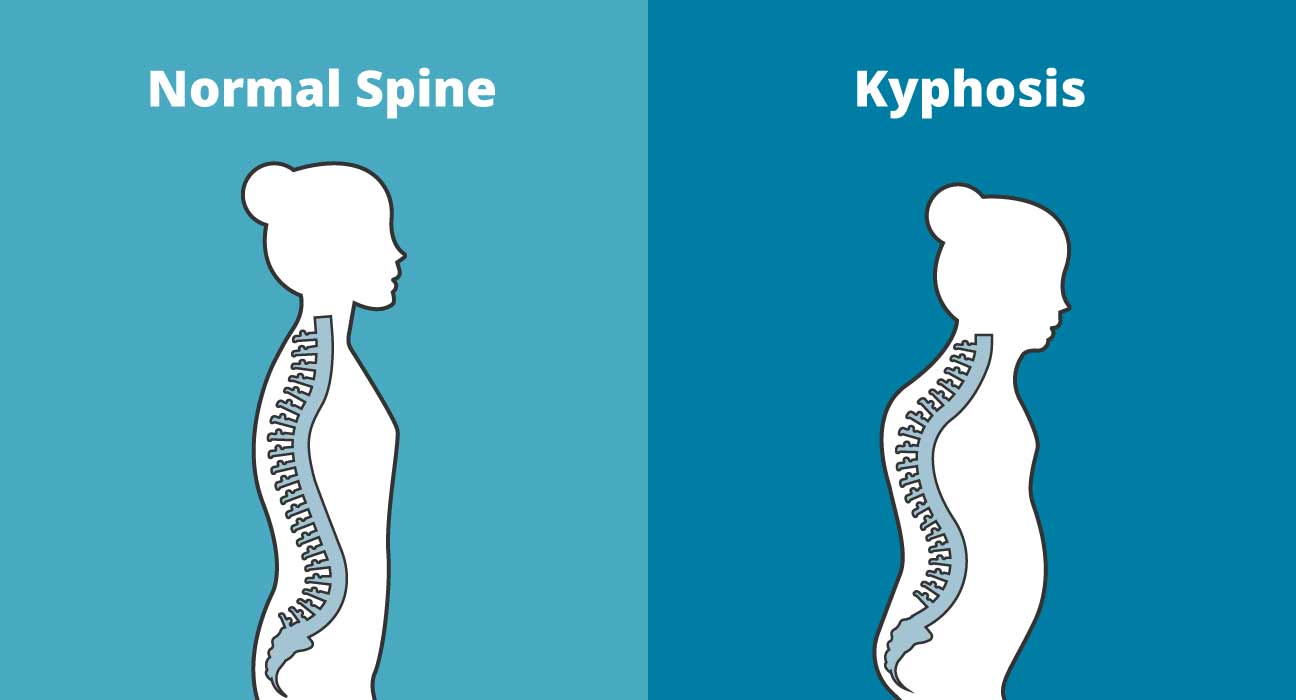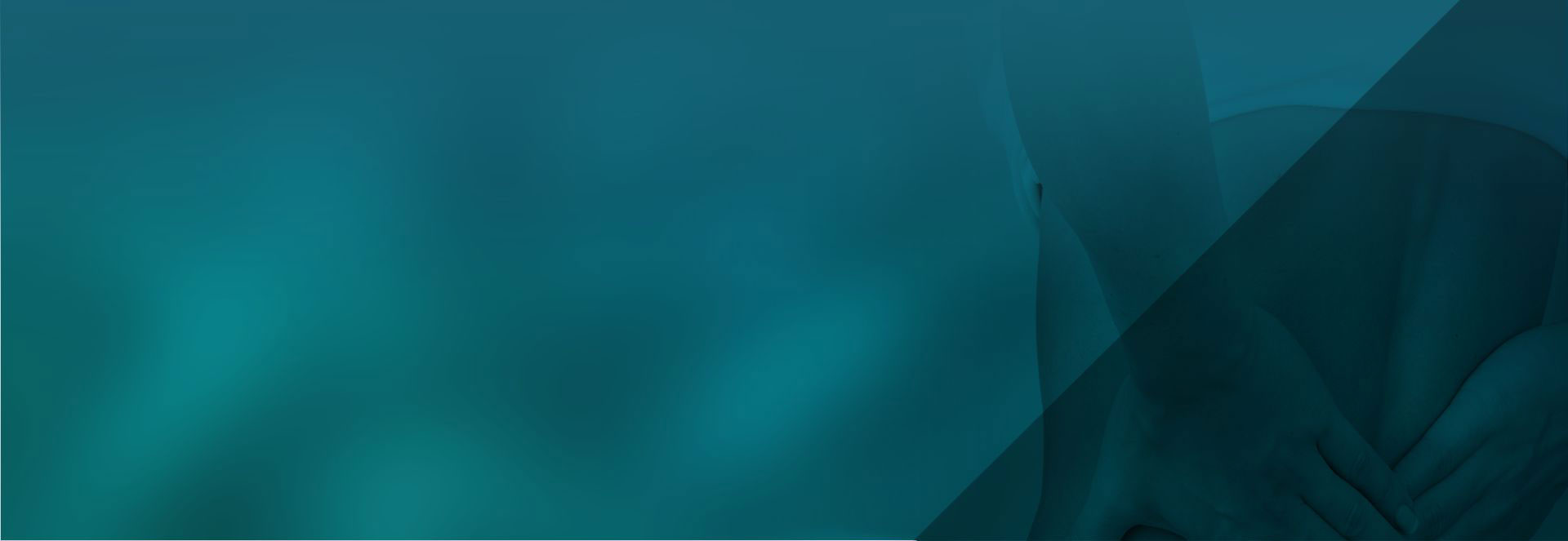- Postural round-back
- Scheuermann's Disease
- Congenital Kyphosis
- Osteoporosis
- Kyphosis associated with neuromuscular disorders
- Kyphosis secondary to trauma, tumours, infection, and arthritis
Kyphosis

What Is Kyphosis?
Kyphosis is a spinal disorder which can look like a person has a ‘humpback’ or ‘hunchback.’ It can be in the form of hyperkyphosis which is a sharp angular deformity also known as 'Gibbus Deformity'.
Kyphotic curves are more common in the thoracic or thoracolumbar spine, but sometimes cervical too. The condition can be due to poor posture or a structural abnormality in the intervertebral discs, muscles, bones, nerves, and ligaments. It is usually measured in degrees of deformity from the norm such as 20-50 degrees and 50-70 degrees. Severe curvatures can affect the lungs and other organs detrimentally. Kyphosis results in a pitched forward head, rather than aligned with the pelvis, which keeps a better distribution of mechanical stress during movement.
Kyphotic curves are more common in the thoracic or thoracolumbar spine, but sometimes cervical too. The condition can be due to poor posture or a structural abnormality in the intervertebral discs, muscles, bones, nerves, and ligaments. It is usually measured in degrees of deformity from the norm such as 20-50 degrees and 50-70 degrees. Severe curvatures can affect the lungs and other organs detrimentally. Kyphosis results in a pitched forward head, rather than aligned with the pelvis, which keeps a better distribution of mechanical stress during movement.
Patient Education Video
Causes of kyphosis include:

What are the Types of Kyphosis?
1. Gibbus Deformity A Gibbus Deformity is a structural form of kyphosis. It is sharply angled and not a smooth curvature. It appears more prominent when bending over to pick something up.
2. Hyperkyphosis This term is usually due to osteoporosis and is an excessive curvature involving several vertebrae of the thoracic spine.
3. Congenital Congenital is a structural disorder is found at birth.
4. Scheuermann's Disease Scheuermann's Disease is an adolescent thoracic kyphosis. It tends to run in families and is a stiff vertebral wedging of greater than 5 degrees involving three vertebrae. The condition usually begins during adolescence and early teenage years and affects females more often than males. Neck and back pain are present in up to 50% of patients.
2. Hyperkyphosis This term is usually due to osteoporosis and is an excessive curvature involving several vertebrae of the thoracic spine.
3. Congenital Congenital is a structural disorder is found at birth.
4. Scheuermann's Disease Scheuermann's Disease is an adolescent thoracic kyphosis. It tends to run in families and is a stiff vertebral wedging of greater than 5 degrees involving three vertebrae. The condition usually begins during adolescence and early teenage years and affects females more often than males. Neck and back pain are present in up to 50% of patients.
How is Kyphosis Diagnosed?
Spine deformity and pain often causes the patient to visit their physician. Physical exam including the Adams Forward Bending Test may reveal thoracolumbar kyphosis. The muscles around the spine may be tender to touch, and range of motion such as flexion, extension, and rotation is impaired. Asymmetry is a common finding. Neurologic signs include numbness, pain, tingling, abnormal sensation or motor control, spasms, weakness, and sometimes bladder or bowel symptoms. Radiographs or X-Rays in the standing and supine positions are taken looking for vertebral wedging and endplate abnormalities. An MRI may be needed to check the condition isn’t affecting any spinal nerves.

How is Kyphosis Treated?
Treatment depends on the cause of the curvature, the degree, the severity of the symptoms, and the rate of progression. Kyphosis of fewer than 50 degrees usually needs no therapy except to encourage exercises that strengthen the core muscles and legs.
Treatment options for kyphosis include nothing, medications, bracing, or surgery may be needed especially if there is still significant growth to be expected and if the curvature is over 50%.
When kyphosis is caused by a complication of osteoporosis or cancer such as a vertebral compression fracture, a procedure called kyphoplasty can be done with minimal downtime. Spinal fusion surgeries are usually reserved for curves greater than 75 degrees if progression is expected or excessive bone loss is anticipated.
Treatment options for kyphosis include nothing, medications, bracing, or surgery may be needed especially if there is still significant growth to be expected and if the curvature is over 50%.
When kyphosis is caused by a complication of osteoporosis or cancer such as a vertebral compression fracture, a procedure called kyphoplasty can be done with minimal downtime. Spinal fusion surgeries are usually reserved for curves greater than 75 degrees if progression is expected or excessive bone loss is anticipated.
Surgery & Treatment for Kyphosis
At Spine Connection we have regenerative and surgical treatments for all spine conditions. As every case is unique we encourage you to receive and compare opinions from our Neurosurgeon and Orthopedic Spine Specialists. We are here to help.
Begin My Assessment
Ask Our Doctors
Join Our Youtube Channel
Watch videos showcasing the latest technologies and surgery techniques, and keep up to date with patient stories from around the globe.








